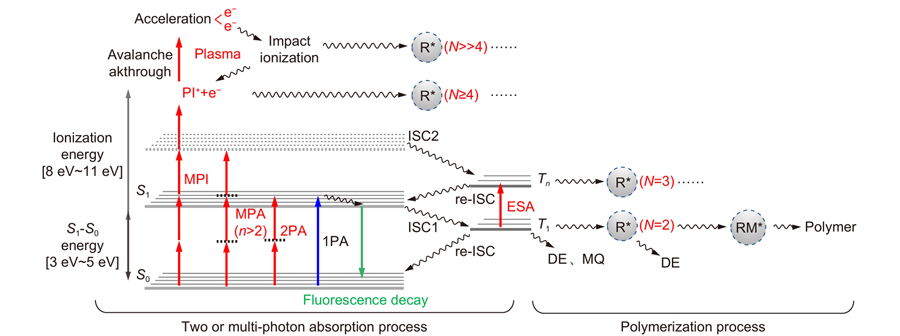
1 暨南大学 光子技术研究院 广东省光纤传感与通信技术重点实验室,广东 广州 511443
2 中国科学院理化技术研究所 仿生智能界面科学中心 有机纳米光子学实验室,北京 100190
Overview: Femtosecond laser two-photon polymerization (TPP) micro-nanofabrication technology is a new type of three-dimensional lithography technology that integrates nonlinear optics, ultra-fast pulsed laser, microscopic imaging, ultra-high-precision positioning, three-dimensional (3D) graphics CAD modeling, and photochemical materials. It has the characteristics of simplicity, low cost, high resolution, true 3D, and so on. Different from the technical route of shortening the wavelength of the traditional lithography, this TPP technology breaks through the optical diffraction limit using the ultrafast laser in the near-infrared and the nonlinear optical effect of the interaction between the laser and the material. TPP can achieve true 3D fabrication of complex 3D structures. After the femtosecond pulse laser is tightly focused in space, photopolymerization is initiated by the two-photon absorption(TPA), which can limit the fabrication area in the center of the focus. The interaction time of the ultrashort pulse with the material is much lower than the thermal relaxation of the material, avoiding the photothermal effect. The lateral linewidth can be reduced to about 100 nm due to the strong threshold characteristics of the two-photon absorption process. Thus, TPP is an ideal fabrication method in the field of 3D micro-nanostructure. Since 2001, Kawata’s team has used a near-infrared femtosecond laser with a wavelength of 780 nm to fabricate a "nanobull" with the size of red blood cells. It fully demonstrated the advantages of TPP in the preparation of three-dimensional micro-nano structures. At the same time, a polymer nanodot with a size of 120 nm was fabricated, which was only 1/7 of the laser wavelength, breaking the optical diffraction limit in this study. Since then, scientists from various countries have improved the line width, resolution, and other parameters of 3D structure by continuously improving the materials, structure, processing technology and light field control, and other aspects. At the same time, with the continuous development and improvement of the 3D nanostructure fabrication technology, the advantages of TPP technology are also reflected in some application fields, such as micro-optical devices, integrated optical devices, micro-electromechanical systems, and biomedical devices. This paper will systematically introduce the femtosecond laser TPP micro-nanofabrication technology, including the fabricating principle, the development of fabricating methods, and its research overview in many application fields. Finally, its existing problems and future development and application prospects are discussed.
飞秒激光 双光子聚合 光学衍射极限 加工分辨力 加工效率 femtosecond laser two-photon polymerization optical diffraction limit resolution efficiency 光学 精密工程
2022, 30(15): 1845
1 上海大学物理系, 上海 200444
2 中国科学院上海光学精密机械研究所强场激光物理国家重点实验室, 上海 201800
3 西安航天复合材料研究所, 陕西 西安 710025
一次性整体成型或传统的加工方式已不能满足聚对苯撑苯并双噁唑(PBO)纤维增强复合材料精密加工和装配的要求。首先分别采用波长为355 nm的紫外皮秒激光和波长为1030 nm的红外皮秒激光对PBO纤维增强复合材料进行切割加工,加工过程中采用渐进式焦点下移和多道扫描策略;然后采用扫描电子显微镜观察了复合材料的切割截面形貌,分析了材料的物理去除机制和加工热损伤;最后研究了激光功率、扫描速度和方向、脉冲重复频率等激光参数与切割质量、切割效率之间的关系。实验结果表明:紫外皮秒激光可以实现“冷加工”和光化学效应,得到了较高的切割质量;激光焦点随加工进程下移可以有效提高加工质量并改善材料切割表面的一致性。研究结果表明,采用8 W、400 kHz、1000 mm/s的激光参数可以进行高质、高效的材料加工。
激光技术 激光与物质相互作用 皮秒激光 聚对苯撑苯并双噁唑纤维增强复合材料 表面质量 热损伤 加工效率 中国激光
2020, 47(10): 1002004
1 中国科学院上海光学精密机械研究所强场激光物理国家重点实验室, 上海 201800
2 上海大学物理系, 上海 200444
激光加工纤维增强复合材料的常见方法是切割、钻孔和表面处理等,本文综述了激光加工纤维增强复合材料的国内外研究进展,重点聚焦碳纤维增强复合材料的激光加工方法,阐述了激光加工纤维增强复合材料的特点和物理去除机制,总结了激光工艺参数对加工质量和加工效率的影响规律,最后展望了激光加工纤维复合材料的发展与挑战。
激光光学 激光加工 纤维增强复合材料 激光与物质相互作用 热损伤 加工效率 激光与光电子学进展
2020, 57(11): 111432
中国科学院 西安光学精密机械研究所, 西安 710119
同轴吹气结构辅助吹气对飞秒激光深孔加工效率有着重要影响, 但在加工过程中存在排渣效果较差等情况。为了提升排渣能力, 采用ANSYS CFD软件分别仿真了同轴吹气、旁轴吹气以及双路吹气的流场分布, 并设计双路辅助吹气实验平台, 进行了理论分析和实验验证, 取得了微孔内部及周围的动态流场和流速矢量分布, 以及同轴、旁轴和双路吹气结构辅助下微孔加工后孔口形貌。结果表明, 双路辅助吹气不但可以提升加工效率, 同时也有助于工件表面洁净度的提升, 对飞秒激光高效深孔加工的实现有着重要意义。
光学制造 加工效率 辅助吹气 流场分析 optical fabrication machining efficiency auxiliary blowing flow field analysis
山东大学 力学与机电装备联合工程技术研究中心, 山东 威海 264209
为实现高回转精度多阶柱状微电极的高效加工, 对多阶柱状电极电化学刻蚀过程进行了深入的研究与改进。首先, 根据电化学刻蚀理论推导了加工电流对电极直径变化的影响规律; 通过试验证明了电极旋转可提高电流变化速率及有效起始电流进而提高加工效率, 定性分析了电极旋转对电极回转精度的影响, 提出了分阶变转速高效加工高回转精度多阶柱状微电极的方法; 通过试验分析了各加工参数(电极转速、加工电压和切断电流)对电极形状及尺寸的影响; 最后, 在优化后的加工参数下, 成功加工得到末端直径小于15 μm且同轴度误差在1 μm以内的多阶柱状微电极, 与常规电化学刻蚀工艺相比, 显著提高了加工效率。试验证明旋转电化学刻蚀是一种能够较好地提高微电极加工效率及回转精度的新工艺。
多阶柱状微电极 加工效率 回转精度 电极旋转 加工电流 multi-stepped cylindrical microelectrode machining efficiency rotating precision electrode rotation machining current
浙江工业大学 机械工程学院,浙江 杭州 310014
针对传统气压砂轮存在磨粒容易脱落,加工效率低等问题,提出了制备渐进式黏磨层气压砂轮的方法。该方法基于分层渐进抛光的思想,在砂轮头表面涂覆多层不同厚度和目数的黏磨层。利用磨粒脱落量及表面加工质量实验确定不同黏磨层光整加工所需时间及厚度, 制备了渐进式黏磨层气压砂轮, 研究了砂轮头的几何精度和加工工件的表面质量。结果表明: 渐进式黏磨层气压砂轮不同黏磨层磨粒目数分别为180#、120#、80#,其厚度分别为2 mm、0.21 mm、0.3mm,各层厚度均符合设计要求,误差在5%以内。在加工过程中,外层黏磨层能在理想时间逐层有效脱落。当下压量为2 mm、磨削转速为1 250 r/min时,渐进式黏磨层气压砂轮能够完成初期光整加工且效率提高19%以上。实验显示: 提出的方法大幅提高了激光强化表面光整加工效率和自动化程度。
气压砂轮 渐进式黏磨层 激光强化表面 分层渐进抛光 磨粒脱落量 加工效率 pneumatic wheel progressive mesh abrasives laser hardening surface layered progressive polishing abrasive dropping amount processing efficiency





